Author: UkuriaOC, CryptoVizArt, Glassnode; Compiler: Baishui, Golden Finance
Summary
As Bitcoin price rises to $100,000, long-term holders begin to distribute more than 507,000 BTC, which is still less than the 934,000 BTC sellers received during the March rally, but still significant.
Long-term holders locked in a significant amount of profits, setting daily realized profits at a new ATH of 2.02B.
When assessing the composition of physical spending, the majority of the selling pressure appears to come from coins between 6 months and 1 year old.
Long-term holders are densely distributed
After a series of continuous new ATHs, the price of Bitcoin is now very close to the impressive and long-awaited price of $100,000 per coin. As in all previous cycles, the long-term holder community is taking advantage of liquidity inflows and strengthening demand to re-start distributing held supply en masse.
Since the LTH supply peak in September, this community has now sold 507,000 BTC. This is a significant amount; however, it is small relative to the 934,000 BTC sold during the ATH rally in March 2024.
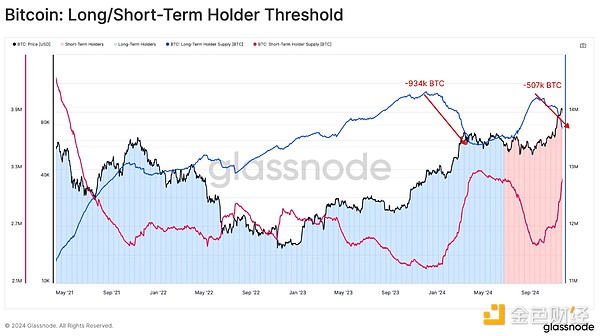
We see a similar picture by assessing the percentage of total supply that are traded from profitable positions by long-term holders. Currently, an average of 0.27% of the LTH supply is sold every day, with only 177 trading days having a higher selling rate.
Interestingly, we can observe that the relative rate of LTH spending is higher than the ATH in March 2024, highlighting more active selling activity.
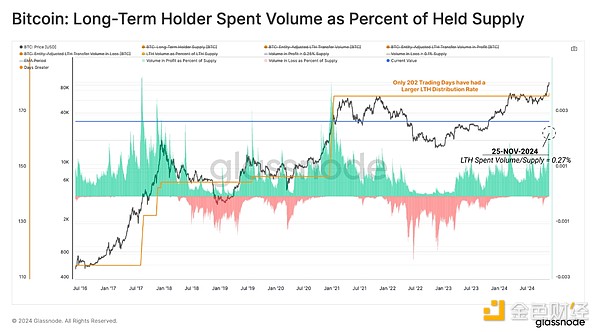
We can also refer to the LTH vitality indicator to assess the balance between Coindays created (holding time) and Coindays destroyed (holding time spent). Generally, an upward trend in vitality is characterized by an environment of increased spending activity, while a downward trend indicates that long-term holding is the main driver.
While the current supply distribution rate is greater than the March peak, Coinday's burns remain low. This highlights that most LTH token transactions are likely to have been acquired recently (e.g., more likely 6 months than 5 years on average).
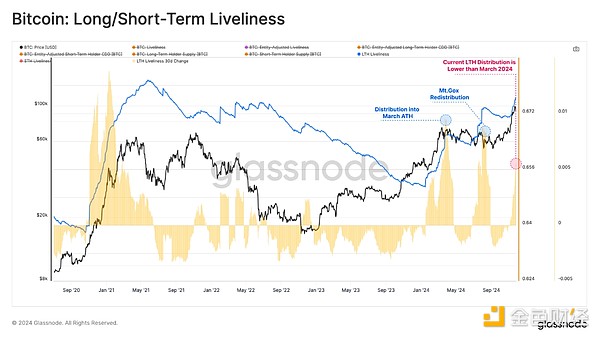
Profit Locking
Long-term holders play a key role in the price discovery process as they are the primary source of previously dormant supply returning to liquidity circulation. As the bull market progresses, it becomes more prudent to assess the extent of profit-taking by this group as they tend to become increasingly active as prices rise.
Long-term holders are currently realizing profits of up to $2.02B per day, setting a new ATH, surpassing the new ATH set in March. A strong demand side is needed to fully absorb this oversupply, which may require a period of re-accumulation to be fully absorbed.
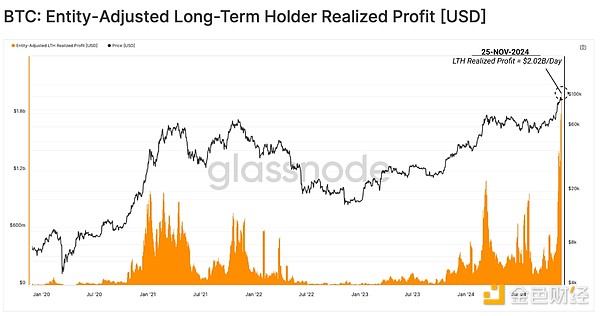
Evaluating the balance between the profit and loss volume of LTH, we can see that the ratio of the two accelerated rapidly in November. By definition, this is due to the lack of LTH supply during this price discovery mechanism.
Historically, assuming a large and sustained inflow of new demand, the price will remain in the optimistic state for several months.

The sell-side risk ratio assesses the total amount of realized profits and losses locked in by investors relative to the size of their assets (measured by realized cap). We can think of this metric under the following framework:
High values indicate that investors are spending tokens at substantial profits or losses relative to their cost basis. This situation indicates that the market may need to re-find equilibrium and is typically accompanied by high volatility price movements.
Low values indicate that most tokens are spending relatively close to their break-even cost basis, indicating that a degree of equilibrium has been reached. This situation usually means that "profits and losses" within the current price range have been exhausted, and generally describes a low volatility environment.
The seller risk ratio is approaching the high range, inferring that significant profit-taking is occurring within the current range. Nevertheless, the current reading remains significantly lower than the final values reached in the previous cycle. This suggests that previous bull markets had enough demand to absorb the supply even under similar relative selling pressure.
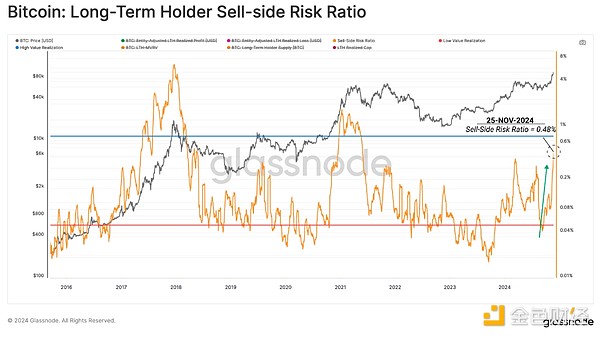
Spending Composition
Having identified a notable uptick in profit taking by long-term holders, we can add granularity to our assessment by scrutinizing the composition of the supply sold.
We can use the age breakdown of the realized profit metric to assess which subgroups are contributing most to the sell-side pressure. Here, we calculate the cumulative profit taking volume by time since the start of November 2024.
6 months-1 year realized profits: $12.6 billion
1-2 years realized profits: $7.2 billion
2-3 years realized profits: $4.8 billion
3-5 years realized profits: $6.3 billion
5+ years realized profits: $4.8 billion
Tokens with a time horizon between 6 months and 1 year dominated the current sell-side pressure, accounting for 35.3% of the total.
The dominance of tokens with a time horizon between 6 months and 1 year highlights that most of the spending came from recently purchased tokens, which highlights that more long-term investors remain cautious and may be patiently waiting for higher prices. One could argue that these selling volumes may describe swing trading style investors who have accumulated funds after the launch of the ETF and plan to ride the next market wave.
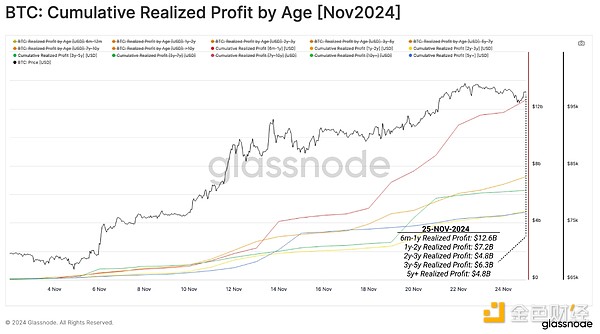
Next, we can apply the same method to the size of profits realized by all investors and categorize them by the percentage of ROI locked in.
0%-20% Realized Profits: $10.1 billion
20%-40% Realized Profits: $10.7 billion
40%-60% Realized Profits: $7.3 billion
60%-100% Realized Profits: $7.2 billion
100%-300% Realized Profits: $13.1 billion
300%+ Realized Profits: $10.7 billion
Interestingly, there is a degree of consistency across the groups, with all groups representing similar percentages of the total. Arguably, this represents an “unrealistic” strategy whereby investors with a lower cost basis achieve similar dollar profits by selling fewer tokens over time.
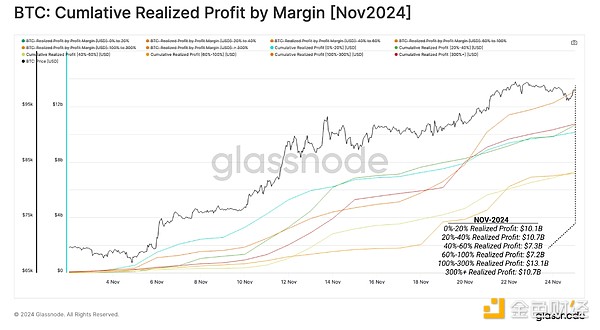
Focusing specifically on tokens purchased during 2021, 2022, and 2023, we can observe a large and sustained spending behavior during the March peak.
However, in the current rally, the selling behavior mainly consists of tokens purchased in 2023, while tokens purchased in 2021 and 2022 are only starting to increase their seller pressure. This is again consistent with the possible explanation of "swing trade" style profit taking as the dominant strategy.
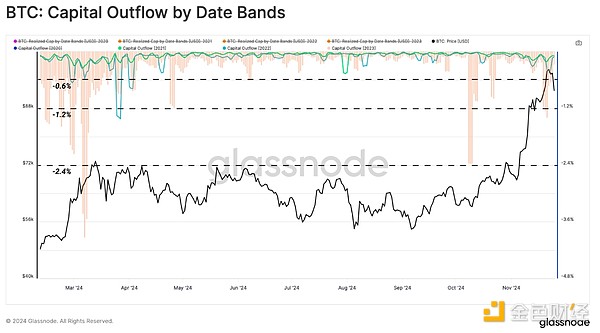
Measuring Sustainability
To gauge the sustainability of this uptrend, we can compare the current structure of URPD to the structure experienced during the March 2024 ATH.
In March 2024, following a few months of appreciation following the ETF launch, several supply clusters changed hands between $40,000 and $73,000. During the seven months of price action that followed, this region became one of the most significant supply clusters in history.
As supply reaccumulated, it formed the final support from which this rally began.
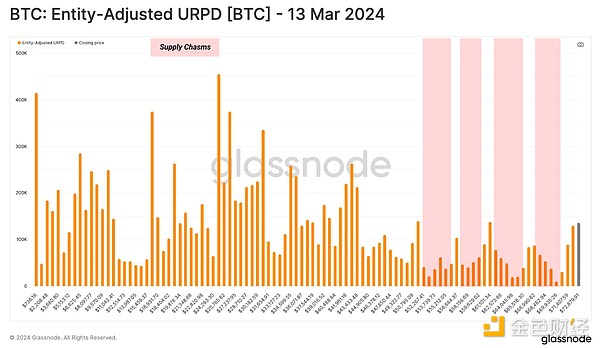
Fast forward to today, the market has rebounded so quickly that few BTC are changing hands between $76,000 and $88,000. From this, two key observations can be identified:
Price discovery is a process that often requires rallies, corrections, and consolidation to confirm a new price range.
There is something of an "air gap" below $88k that could become an area of interest if the market pulls back lower before retrying a breakout above $100k.
As the market attempts to re-find equilibrium in this price discovery mechanism, changes in the supply distribution can provide insight into supply and demand areas of interest.

Summary
Long term holders are selling on the back of rising prices. This creates a supply glut that must be absorbed to accommodate continued price increases.
When assessing the composition of entity spending, the majority of the sell-side pressure appears to be coming from BTC between 6 months and 1 year old. This highlights the potential for further selling from older entities that require higher prices to sell their BTC.
 JinseFinance
JinseFinance














